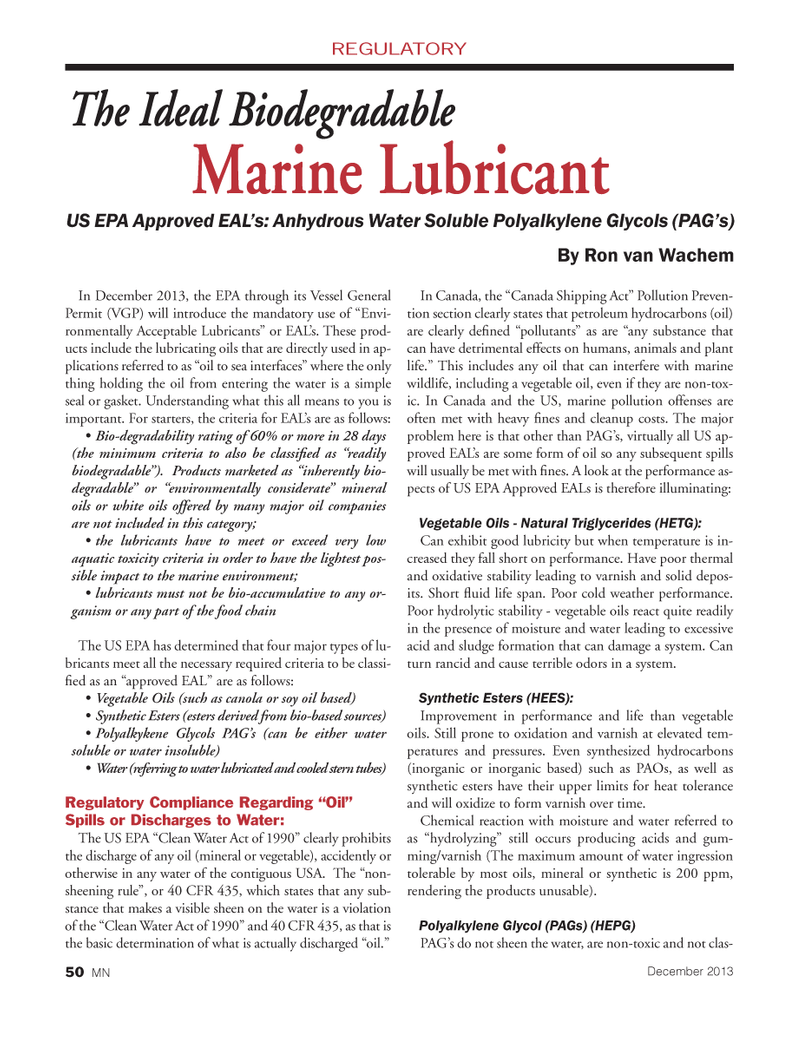
Page 50: of Marine News Magazine (December 2013)
Innovative Products & Boats of 2012
Read this page in Pdf, Flash or Html5 edition of December 2013 Marine News Magazine
REGULATORY In December 2013, the EPA through its Vessel General Permit (VGP) will introduce the mandatory use of ?Envi- ronmentally Acceptable Lubricants? or EAL?s. These prod- ucts include the lubricating oils that are directly used in ap- plications referred to as ?oil to sea interfaces? where the only thing holding the oil from entering the water is a simple seal or gasket. Understanding what this all means to you is important. For starters, the criteria for EAL?s are as follows: Bio-degradability rating of 60% or more in 28 days (the minimum criteria to also be classi ed as ?readily biodegradable?). Products marketed as ?inherently bio- degradable? or ?environmentally considerate? mineral oils or white oils offered by many major oil companies are not included in this category; the lubricants have to meet or exceed very low aquatic toxicity criteria in order to have the lightest pos- sible impact to the marine environment; lubricants must not be bio-accumulative to any or- ganism or any part of the food chain The US EPA has determined that four major types of lu- bricants meet all the necessary required criteria to be classi- ed as an ?approved EAL? are as follows: Vegetable Oils (such as canola or soy oil based) Synthetic Esters (esters derived from bio-based sources) Polyalkykene Glycols P AG?s (can be either water soluble or water insoluble) Water (referring to water lubricated and cooled stern tubes) Regulatory Compliance Regarding ?Oil? Spills or Discharges to W ater:The US EPA ?Clean Water Act of 1990? clearly prohibits the discharge of any oil (mineral or vegetable), accidently or otherwise in any water of the contiguous USA. The ?non- sheening rule?, or 40 CFR 435, which states that any sub- stance that makes a visible sheen on the water is a violation of the ?Clean Water Act of 1990? and 40 CFR 435, as that is the basic determination of what is actually discharged ?oil.? In Canada, the ?Canada Shipping Act? Pollution Preven- tion section clearly states that petroleum hydrocarbons (oil) are clearly de ned ?pollutants? as are ?any substance that can have detrimental effects on humans, animals and plant life.? This includes any oil that can interfere with marine wildlife, including a vegetable oil, even if they are non-tox- ic. In Canada and the US, marine pollution offenses are often met with heavy nes and cleanup costs. The major problem here is that other than PAG?s, virtually all US ap- proved EAL?s are some form of oil so any subsequent spills will usually be met with nes. A look at the performance as- pects of US EPA Approved EALs is therefore illuminating: Vegetable Oils - Natural Triglycerides (HETG): Can exhibit good lubricity but when temperature is in- creased they fall short on performance. Have poor thermal and oxidative stability leading to varnish and solid depos- its. Short uid life span. Poor cold weather performance. Poor hydrolytic stability - vegetable oils react quite readily in the presence of moisture and water leading to excessive acid and sludge formation that can damage a system. Can turn rancid and cause terrible odors in a system.Synthetic Esters (HEES): Improvement in performance and life than vegetable oils. Still prone to oxidation and varnish at elevated tem- peratures and pressures. Even synthesized hydrocarbons (inorganic or inorganic based) such as PAOs, as well as synthetic esters have their upper limits for heat tolerance and will oxidize to form varnish over time. Chemical reaction with moisture and water referred to as ?hydrolyzing? still occurs producing acids and gum- ming/varnish (The maximum amount of water ingression tolerable by most oils, mineral or synthetic is 200 ppm, rendering the products unusable). Polyalkylene Glycol (PAGs) (HEPG) PAG?s do not sheen the water, are non-toxic and not clas- The Ideal Biodegradable The Ideal Biodegradable Marine Lubricant Marine Lubricant US EPA Approved EAL?s: Anhydrous Water Soluble Polyalkylene Glycols (PAG?s) By Ron van Wachem December 201350 MNMN Dec2013 Layout 50-58.indd 50MN Dec2013 Layout 50-58.indd 5011/25/2013 1:22:59 PM11/25/2013 1:22:59 PM

 49
49

 51
51
